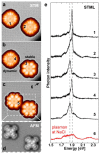Mechano-Optical Switching of a Single Molecule with Doublet Emission
- PMID: 32539338
- PMCID: PMC7116298
- DOI: 10.1021/acsnano.0c03730
Mechano-Optical Switching of a Single Molecule with Doublet Emission
Abstract
The ability to control the emission from single-molecule quantum emitters is an important step toward their implementation in optoelectronic technology. Phthalocyanine and derived metal complexes on thin insulating layers studied by scanning tunneling microscope-induced luminescence (STML) offer an excellent playground for tuning their excitonic and electronic states by Coulomb interaction and to showcase their high environmental sensitivity. Copper phthalocyanine (CuPc) has an open-shell electronic structure, and its lowest-energy exciton is a doublet, which brings interesting prospects in its application for optospintronic devices. Here, we demonstrate that the excitonic state of a single CuPc molecule can be reproducibly switched by atomic-scale manipulations permitting precise positioning of the molecule on the NaCl ionic crystal lattice. Using a combination of STML, AFM, and ab initio calculations, we show the modulation of electronic and optical bandgaps and the exciton binding energy in CuPc by tens of meV. We explain this effect by spatially dependent Coulomb interaction occurring at the molecule-insulator interface, which tunes the local dielectric environment of the emitter.
Keywords: AFM; CuPc; NaCl; STML; doublet; exciton; switching.
Figures




References
-
- Moerner WE. Examining Nanoenvironments in Solids on the Scale of a Single, Isolated Impurity Molecule. Science. 1994;265:46–53. - PubMed
-
- Moerner WE. Nobel Lecture: Single-molecule spectroscopy, imaging, and photocontrol: Foundations for super-resolution microscopy. Rev Mod Phys. 2015;87:1183–1212. - PubMed
-
- Zhu XY, Yang Q, Muntwiler M. Charge-Transfer Excitons at Organic Semiconductor Surfaces and Interfaces. Acc Chem Res. 2009;42(11):1779–1787. - PubMed
-
- Ugeda MM, et al. Giant bandgap renormalization and excitonic effects in a monolayer transition metal dichalcogenide semiconductor. Nat Mater. 2014;13:1091–5. - PubMed
LinkOut - more resources
Full Text Sources
Miscellaneous

